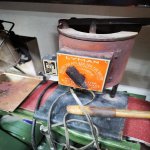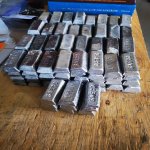Very interesting and detailed info...thanks for this.
Late last week I tried reloading 10 rounds each of CFE Pistol at 6.9gr/7.1gr/ and 7.3 gr. All three seemed to shoot well in the Para so I settled on 7.3gr and reloaded a bunch at that weight. Hope to try them a little more next week. I also came into a couple old pots and a bunch of lead a while back and eventually I'd like to try casting bullets but I have no idea where to start but will try at some point I guess and see if those two old pots work.
The only handgun I cast is the RCBS hollow base replica mould for the .455 Webley ball round. For all my .38 Spl, 9mm, .40 and 10mm things, the juice isn't worth the squeeze - in normal times, if you keep your eyes open and jump on the sales, blemishes, etc you can save a lot of money and your time buying your bullets in 1000, 5000, etc lots. Seems spendy at the time, but a lot cheaper than if you were to buy them by the 250, 500, etc. every couple of months.
I have some friends who have told me that if I'd drop my prejudice and buy a gang mould, I'd change my mind on casting for handgun. Nah, I don't think so... cast bullets by the thousands ain't my thing when I can buy them by the thousands in normal times. But if you're stuck... Midway has Lee six cavity .40 gang moulds for about $55 USD. 175 gr bullet - more lead than I'd want to use up per bullet, but on the shelf ready to go.
I don't know anything about the availability of handgun bullet moulds these days, whether commercially or being sold by casters her on the EE or similar forums. For your described handgun plinking, you probably won't need a lubrisizer. A Lee push through sizer or one of NOE's cool resizer kits should do if necessary. And for plinkers, I'd never go back from shake and bake powder coating to lubrisizers, tumble lubing, or anything like that.
That Saeco is probably in good shape and it's ancestor being sold these days hasn't changed much except for cosmetics. I look on Lee's pots suspiciously as probable drip-o-matics. It's annoying, if it is, a small pie plate under it will deal with the drips. Lots of guys have posted that they eliminated the drip with a good cleaning and lapping the needle so that it properly seated into the spout.
From what little I can see of your pots, I suspect they need a good cleaning - which helps keep crap from finding it's way into the spouts of bottom pour pots. You'll find lots of info on cleaning casting pots, on rebuilding rheostats, etc all over the internet. I've never put anything but cleaned alloy in my pot and I keep them clean so in my limited experience to cleaning well maintained pots, cleaning involves doing nothing more than filling them with water, turning them on, and boiling water in them until all the crud and whatnot has lifted off, dissolved, etc.
Store them filled with alloy right to the top if you can; keeps air from getting at and working on surfaces. Or run them empty, then boil them clean and ready to go the next time.
The learning curve for casting when starting out is pretty steep for the first few days; when I started in the 70's, I felt like I was dipping into Voodoo with the old Lyman manual I had. Nobody I knew casted bullets. These days there is so much information, forums, etc on the Internet that you can't go browsing without stumbling over it.











































































